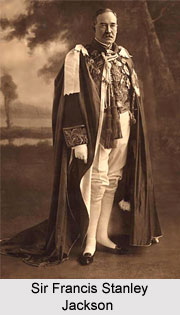 Francis Stanley Jackson, also known as Sir Francis Stanley Jackson, GCSI, GCIE, PC, KStJ, served as one of the Governors of Bengal Presidency from the year 1927 to 1932. He was a well known an English cricketer and a soldier. Jackson was also one of the renowned a colonial administrators and a Conservative Party politician in erstwhile British India. Jackson was renowned as the Honourable Stanley Jackson through out his playing career.
Francis Stanley Jackson, also known as Sir Francis Stanley Jackson, GCSI, GCIE, PC, KStJ, served as one of the Governors of Bengal Presidency from the year 1927 to 1932. He was a well known an English cricketer and a soldier. Jackson was also one of the renowned a colonial administrators and a Conservative Party politician in erstwhile British India. Jackson was renowned as the Honourable Stanley Jackson through out his playing career.
Early Life of Francis Stanley Jackson
Francis Stanley Jackson was born on 21 November 1870 in Chapel Allerton, Leeds in West Yorkshire, England. He was the son of William Jackson, 1st Baron Allerton. He completed his education from Harrow School. He later did his higher studies from Trinity College in Cambridge in the year 1889.
Cricket Career of Francis Stanley Jackson
Sir Francis Stanley Jackson, GCSI, GCIE, PC, KStJ played cricket for Cambridge University in Yorkshire and England. In 1894, he was named a Wisden Cricketer of the Year. Jackson also captained England in 5 Test matches in the year 1905. He won 2 matches, drawing 3 matches to retain The Ashes. He was appointed as the President of the MCC in the year 1921. Later in 1938, Jackson succeeded Lord Hawke as President of Yorkshire CCC.
Political Career of Francis Stanley Jackson
Francis Stanley Jackson served in the Royal Lancaster Regiment of Militia in the Second Boer War. Later in 1914, he was reassigned as a Lieutenant Colonel to the West Yorkshire Regiment. In February 1915, he was elected as a Member of Parliament at the By-election and represented Howdenshire in Yorkshire. He resigned from his seat on 3 November 1926. Jackson also acted as the Financial Secretary to the War Office from 1922 to 1923.
Francis Stanley Jackson was appointed as the Governor of Bengal Presidency in the year 1927. He was preceded by Sir Victor Alexander George Robert Bulwer Lytton, 2nd Earl of Lytton KG, GCSI, GCIE, PC, DL in the post of the Governor of Bengal. The Bengal Presidency originally comprised east and west Bengal and was a colonial region of the British Empire in India. The region included the territories of undivided Bengal like West Bengal, Tripura, Orissa, Meghalaya, Bihar, Assam and modern Bangladesh. Jackson served in office till the year 1932 and was succeeded by Sir John Anderson, 1st Viscount Waverley, GCB, OM, GCSI, GCIE, PC, PC.
Personal Life of Francis Stanley Jackson
Sir Francis Stanley Jackson, GCSI, GCIE, PC, KStJ died on 9 March 1947 at the age of 76 years at Hyde Park in London, England. He died due to a road accident.
Honours of Francis Stanley Jackson
Jackson was knighted with the Knight Grand Commander of The Most Eminent Order of the Indian Empire (GCIE) in 1927 and was made a member of the Privy Council. He was also honoured with Knight of Justice or Grace of The Most Venerable Order of the Hospital of Saint John of Jerusalem (KStJ) in 1932. Francis Stanley Jackson was made Knight Grand Commander of The Most Exalted Order of the Star of India (GCSI) in the same year.



















